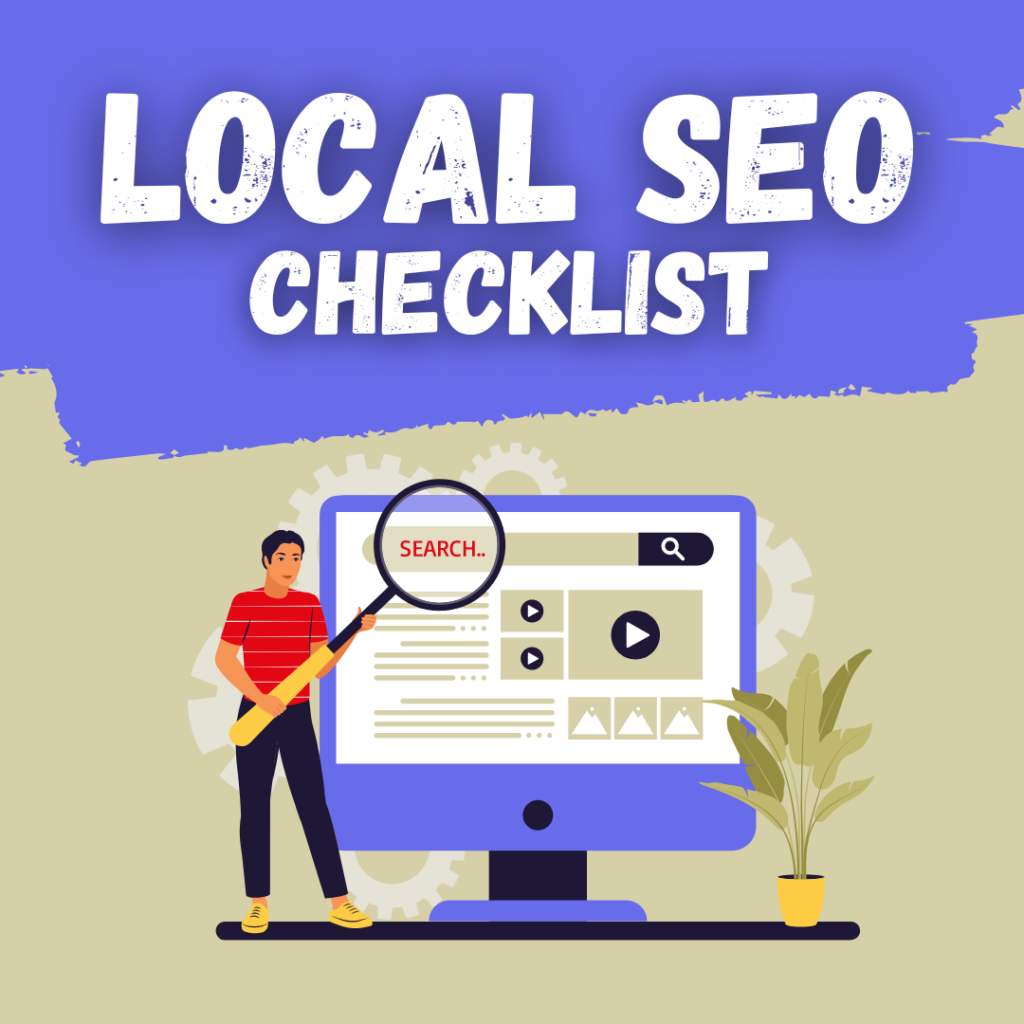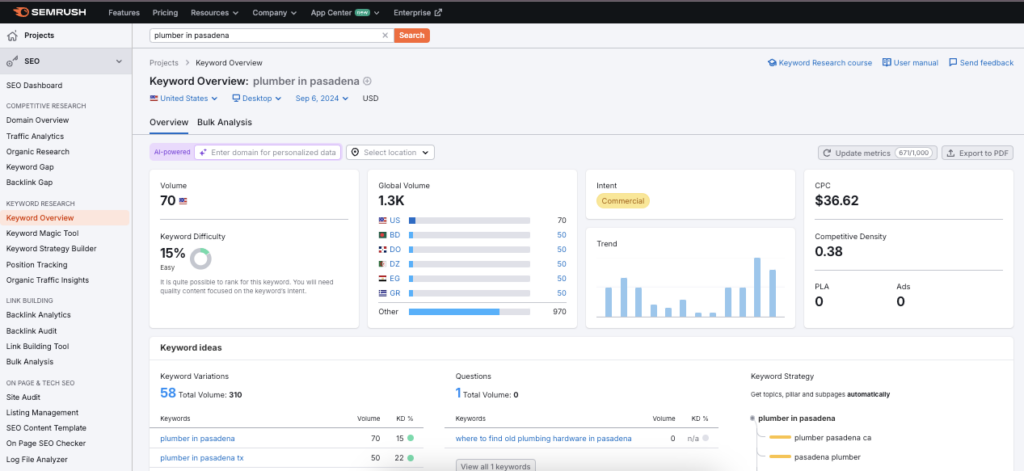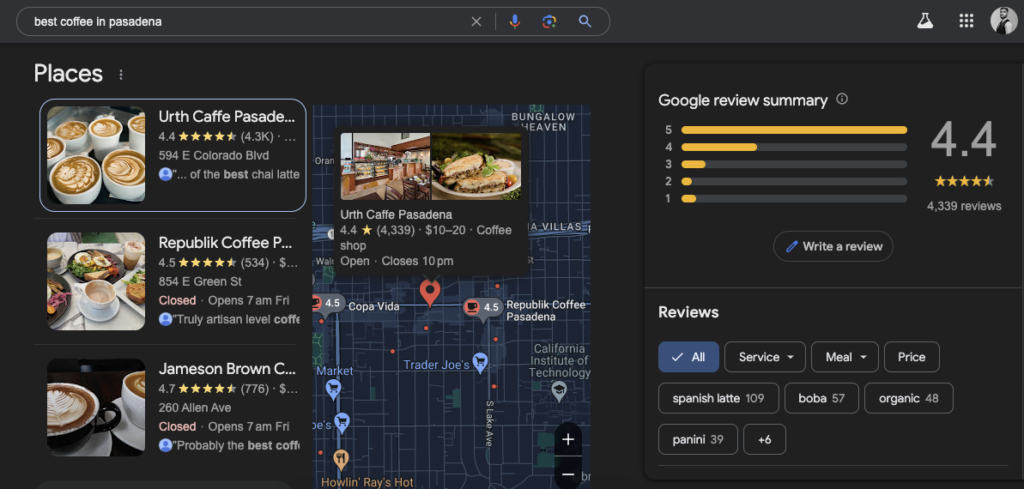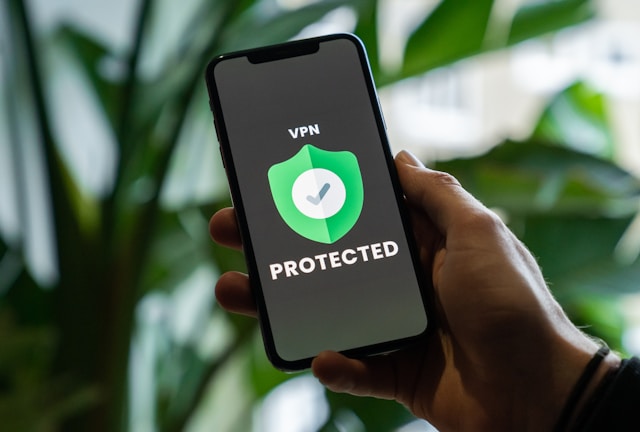What is a local SEO checklist, and why should you care?
Have you ever dined at a local restaurant with amazing food but wondered why this restaurant doesn’t have more customers? The reason could be the neglect of their online presence, especially on search engines like Google.
Having a strong digital presence is just as crucial as providing top-notch service. While having a digital presence is easy, making it strong and marketing it is the trickier part. This is where you’ll need a local SEO strategy.
It’s what helps local businesses show up in search results of potential customers. Without it, even the best businesses can go unnoticed.
In this blog, we’ll discuss how to implement local SEO. But before we start, let’s learn what local SEO means!

Table of Contents
What Is Local SEO?
Local SEO involves optimizing a business’s online presence to attract more customers from relevant local searches.
For instance, let’s say you’re running a small coffee shop in a local town of, let’s say, Pasadena. When someone searches for “best coffee in Pasadena,” local SEO helps your business show up in those search results. Its primary purpose is to connect local businesses with people searching for products or services within their immediate geographic area.
Local SEO targets a much smaller, more defined audience — people likely to visit your physical location, aka potential customers.
Proximity to the customer plays a big role in the decision-making process for services or brick-and-mortar businesses like:
- Restaurants
- Retail stores
- Gyms
This is especially helpful for small businesses that struggle to compete with large, well-established brands.
Mobile search has further amplified the importance of Local SEO. With smartphones in almost every pocket, people are searching on the go more than ever.
They might be in a new part of town and want to find a place to eat. Perhaps they need a quick service nearby. Local SEO ensures that when they pull out their phones and search on Google, your business is right there.

What Is a Local SEO Checklist?
The local SEO checklist contains the steps you need to take to fulfill local SEO requirements for ranking your business. To do that, you must have a local SEO strategy.
At a high level, local SEO works by making sure your business information is accurate and consistent across the web. Maintaining your GMB, Google My Business, (now Google Business Profile) is necessary for ranking higher on Google search and Google Maps.
Local SEO also ensures your business name, address, and phone number (NAP) are the same everywhere they appear online. This means you’ll need to optimize your website and content to include location-based target keywords.
Positive reviews and ratings on Google are also key ranking factors in local search results.
Now that you understand local SEO, here is the 6-step local SEO checklist you should follow to rank high.
1. Keyword Research
Keyword research is the starting point of any SEO strategy. For local SEO checklist, it involves identifying the specific search terms people in your area are using to find businesses like yours.
To do that, you should go after local keywords (keywords that are location-specific).
For example, a generic keyword like plumber won’t work in local SEO. Instead, focus on localized terms like the best plumber in Pasadena or plumbing service near me.
- Start with seed keywords: Seed keywords are terms in your niche that you can use to create many relevant keywords. For example, if you’re a bakery, your seed keywords might include cakes, pastries, or baked goods.
- Use tools for localized keywords: Use tools like Google Keyword Planner to find localized versions of these keywords. You can also use Google’s autocomplete or the People also ask section to gather ideas.
- Focus on long-tail keywords: Local SEO thrives on long-tail keywords. These are phrases like best pizza in downtown Denver or affordable home cleaning in Brooklyn. Long-tail keywords are typically less competitive but highly specific.
- Analyze competitors: Analyze the websites of your area competitors. What keywords are they ranking for? You can use SEO tools like SEMrush to check this and fill any gaps.

2. On-Page SEO
On-page SEO refers to optimizing the landing pages of your website so that search engines can easily understand and rank them. Here’s how you should handle on-page SEO in your local SEO checklist.
Optimize Title Tags and Meta Description
Ensure your title tags include relevant local keywords. For instance, a dentist in San Diego could have a title like Experienced Dentist in San Diego | Affordable Dental Care.
Your meta description should also have local keywords, and it needs to be enticing enough for users to click through to your website. Also, manage your hreflang tags.
Use Localized Headings
Your page’s headings (H1, H2, H3, etc.) should also incorporate local keywords. This helps Google understand the context of your page. A heading like Our Coffee Shop in Austin works better than a generic one like About Us.
NAP Consistency
Ensure your business’s name, address, and phone number (NAP) are visible on each website page, ideally in the footer. Consistency is key here, as search engines cross-check this information with other listings across the web.

Embed Google Maps
Adding a Google Maps embed to your contact page or homepage is an easy way to reinforce your location. This helps visitors find you easily while also sending a signal to Google about your exact location.

Image Optimization
Don’t forget to optimize your images by using descriptive file names and alt text. Let’s say you run a local landscaping business. If you upload a photo of your team doing landscaping, your image alt text could read landscaping services in Houston.
Avoid something generic like IMG1234.jpg.
Content Length and Quality
Google tends to favor content that satisfies the intent of the user’s search query. If what users are searching for requires an in-depth explanation, cover the topic in depth. If the content requires a to-the-point answer, don’t try to write long descriptions for it.
Take this blog as an example. I am writing this article on a local SEO checklist, which requires me to go in-depth. That’s why the length of this content is long.
Whether you’re writing long or short-form content, make sure it’s well-written and provides a clear answer to the query.
Your pages must provide valuable information and answer local questions. In some cases, a page with 300-500 words might not perform as well as one with 800-1,000 words of rich content. Also, avoid robotic and duplicate content.

3. Google Business Profile Setup and Optimization
Setting up and optimizing your Google Business Profile is mandatory in any local business SEO checklist.
Using this tool, you can manage how your business appears in local searches made on Google Search and Maps:
- Claim your profile: If you haven’t already, claim your business on Google. It’ll allow you to control what information your business displays to the world.
- Fill out all information: Be thorough when entering your business name, address, phone number (NAP), and business hours. Ensure these details match the information across all online listings. This consistency helps search engines trust your business listing.
- Add high-quality photos: Images of your shop, products (like cakes and pastries), and even behind-the-scenes shots build trust with potential customers.
- Choose the right categories: Google allows you to select primary and secondary categories for your business. For example, if a bakery also offers catering, select Bakery as the primary category and Catering as a secondary one.

4. Use Customer Reviews To Build Reputation
Customer reviews are one of the strongest ranking factors in local SEO strategy. Your business should treat customers in a way that keeps its overall reviews and ratings positive.
Avoid incentivizing reviews, as this can violate Google’s guidelines and hurt your business in the long run. Instead, focus on providing great customer experiences to earn genuine, positive feedback. Here’s what you can do:
- Encourage reviews: Politely ask satisfied customers to leave a review on your Google Business Profile. For example, a bakery could include a small card with their orders asking customers to Leave us a review on Google!
- Respond to reviews: Whether positive or negative, always respond to customer reviews. Thanking customers for positive reviews reinforces good relationships, while addressing negative reviews shows you care about resolving issues. Always apologize and offer to make things right for unhappy customers or detractors.
- Highlight positive reviews: Showcase glowing reviews on your website or social media. For example, if someone praises your bakery’s birthday cakes as the best in town, feature that in your marketing materials.

5. Leverage Local Link Building
Local link-building involves backlinks from reputable local websites to boost your website’s authority and relevance in local searches. When other authoritative sites link to your site, it signals to search engines that your business is credible.
Once you’re in the good books of search engines, working your way to the top of rankings will get easier. Backlinks will also drive referral traffic from local audiences.
Here’s what it takes to check off local link building from your local SEO checklist.

Partner With Local Businesses
Reach out to complementary local businesses for cross-promotion opportunities. For example, a bakery can partner well with a nearby coffee shop or catering company. Each business can link to the other’s website through blog posts, event pages, or partnership announcements.
Sponsor Local Events or Charities
By sponsoring local events or contributing to charities, you can often gain a backlink from their websites. For instance, if you sponsor a local food festival, request a link back to your site from their promotional pages.
Create Locally Relevant Content
Develop content that ties into your community. Write blog posts about local events or share baking tips specific to your region.
For example, “Top 5 Pastries to Enjoy at New York Festivals” could encourage local bloggers to link to your post.

6. Build Local Citations
Local citations refer to mentions of your business on other websites, typically in the form of your business NAP.
These citations can appear in business directories, local blogs, or government pages. Accurate and consistent citations are essential for search engines to verify your business’s legitimacy and help improve your local rankings.
- List your business in local directories: Add your business listing in reputable online directories, such as Yelp, Yellow Pages, and local chamber of commerce sites. For instance, you can add your bakery to food and beverage directories or event catering lists in your area.
- Ensure NAP consistency: NAP consistency is important across all platforms, not just your own site. Try making it exactly the same, whether it’s on your Google Business Profile, your website, or a local business listing.
- Leverage niche-specific directories: In addition to broad directories, look for industry-specific directories relevant to your business.
Now, let’s see what you should look for when doing your local SEO audit.

Local SEO Audit Checklist
A Local SEO audit is a comprehensive review of all the major tasks of a local SEO checklist. It’s an essential step to identify any gaps or issues in your local SEO strategy.
The local SEO audit checklist contains tasks that evaluate important ranking factors. These factors include:
- Google Business Profile review: Ensure that your Google Business Profile is complete. Verify that your NAP is accurate and consistent. Ensure to include relevant details like operating hours, services, and images.
- Website performance check: Test your website’s loading speed, mobile-friendliness, and overall user experience. The site should be responsive on mobile devices. Google’s PageSpeed Insights can be helpful here.
- On-page SEO audit: Review your on-page SEO factors, such as title tags, meta descriptions, and internal links. Ensure the target keyword appears naturally on key pages.
- Backlink analysis: Evaluate the quality and quantity of local backlinks pointing to your site.
- Citations and NAP consistency: Make sure NAP is consistent across all local directories. Run regular citation audits to fix inconsistencies.
- Review management: Assess the number and quality of your customer reviews. Check if you’ve responded to them.

Bonus Tip: Focus on Keyword Position Tracking
Keyword position tracking means monitoring where your website ranks for specific target keywords on search engine results pages (SERPs). Tracking these positions over time allows you to gauge the effectiveness of your SEO strategy.
You need to track these to keep a check on any fluctuations that may need attention:
- Monitor keyword rankings: Keyword position tracking tools like SEMrush or Ahrefs allow you to track the rankings of your website’s pages for specific keywords. You simply give them information about your site along with your target keywords. The tool will then tell you which specific pages on your website rank for each target keyword.
- Set alerts for changes: Many tools allow you to set up notifications when a keyword’s position changes. For example, if a target keyword suddenly drops from page 1 to page 3, SEMrush will alert you about its change in position.
- Track competitor rankings: These tools also let you track where your competitors rank for similar keywords. This can tell you about keywords you should improve and those you should maintain your position for.

FAQ
Here are some answers to the questions you may have regarding local SEO.
Why is Local SEO important?
Local SEO helps businesses increase visibility in local search results. It makes it easier for nearby customers to find and visit them.
Who uses local SEO?
Local SEO is used by any business that serves a specific geographic area. They can be restaurants, local shops, medical offices, and service providers like plumbers or electricians.
What is an example of a local SEO?
An example of local SEO is optimizing a Google Business Profile for a coffee shop. A coffee shop can ensure it appears in “near me” searches and on Google Maps.
Use geoPlugin To Verify Genuine Local Traffic!
You implement each task in the local SEO checklist, and now you’re waiting to see results through tools like SEMrush. Days pass but the keywords position tracking features show no notable activity.
Does this mean you’ve done a bad job at local SEO? That can very well be the reason in some cases.
But before jumping to that conclusion, you should run other tests to verify whether that’s the case. Sometimes, Google takes time to index pages, especially when they’re new and small.
However, if you want to analyze the IP address of your site visitors, you can do that using the IP geolocation API by geoPlugin.
It can provide information about your visitors’ IPs and let you provide a personalized experience.
So try geoPlugin today and boost your performance.













